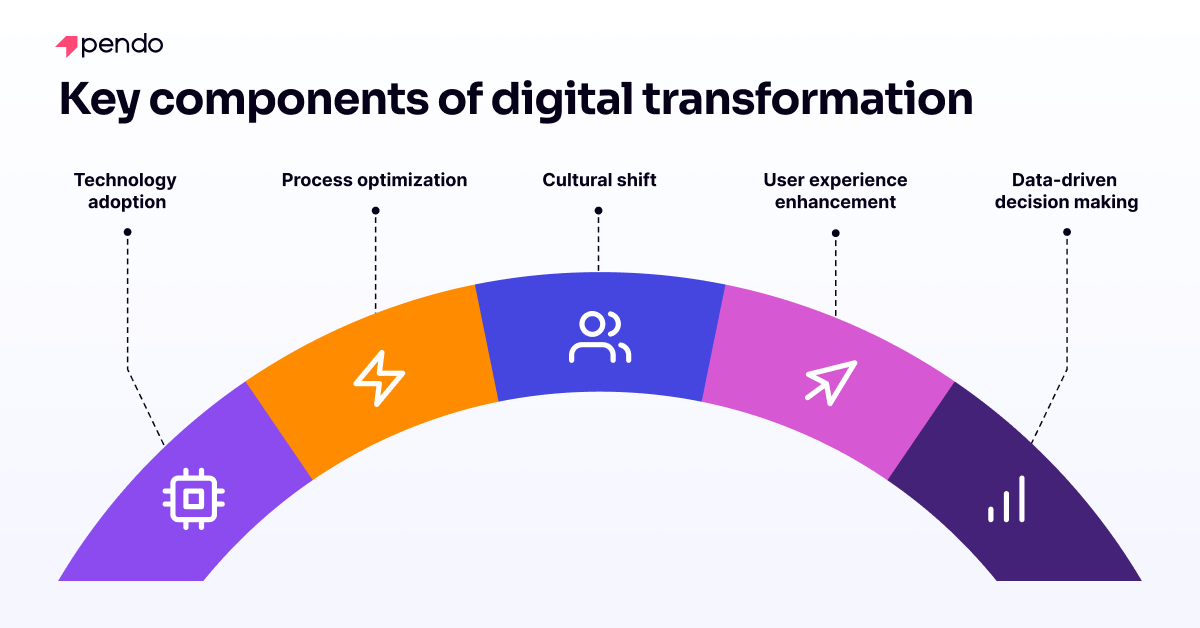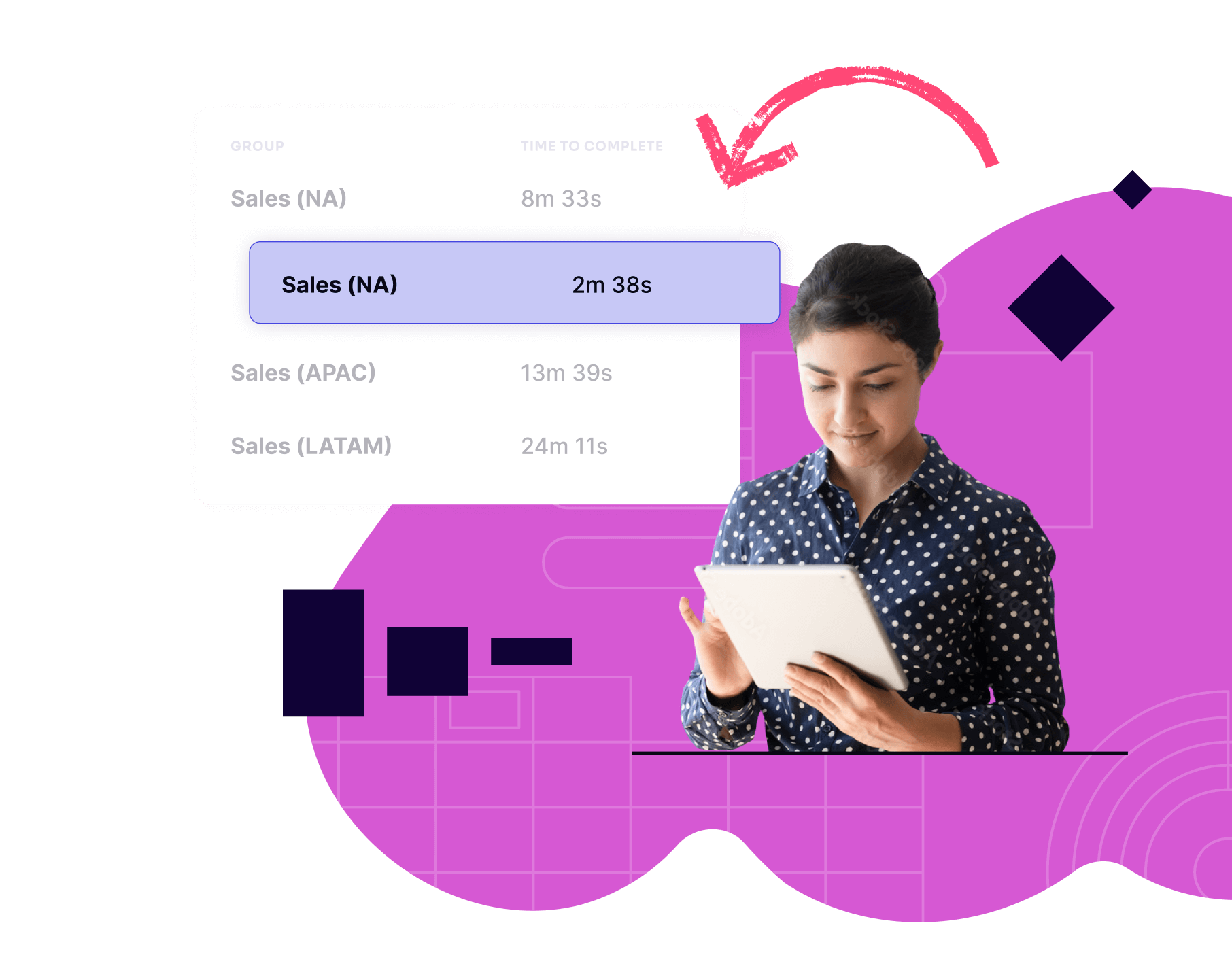
THE COMPREHENSIVE GUIDE TO
Digital transformation
The process of integrating digital technologies into any or all aspects of a business or organization, fundamentally changing how it operates and delivers value to its customers.
Dive deeper
Table of Contents
What is digital transformation?
Digital transformation refers to the process of integrating digital technologies into any or all aspects of a business or organization, fundamentally changing how it operates and delivers value to its customers. It involves leveraging digital tools and technologies to streamline processes, enhance customer experiences, and drive innovation across various functions and departments.
Because digital transformation can be applied to a broad spectrum of changes, businesses can tailor their approach based on their specific needs and goals. This flexibility can, however, lead to varying interpretations of what “digital transformation” truly means. For some organizations, digital transformation may involve no more than adopting a few digital tools to replace selected manual processes. Others pursue a complete overhaul, embracing the latest emerging technologies and fundamentally changing their business model. While most organizations’ digital transformation initiatives lie in between, they all share one thing in common: digital adoption is crucial to their success.
Why is digital transformation important?
Digital transformation is essential for an organization to stay competitive in today’s rapidly evolving business landscape. It allows companies to adapt to changing market demands, improve operational efficiency, and capitalize on opportunities presented by new technological advances. Here are some ways embracing digital transformation helps ensure the modern business organization stays ahead.
Adapting to evolving customer needs: Today’s customers are tech-savvy and expect seamless digital experiences. Digital transformation allows businesses to leverage technology to:
- Personalize customer interactions: By gathering and analyzing customer data, businesses can personalize product recommendations, offers, and marketing campaigns, leading to higher customer satisfaction and loyalty.
- Offer omnichannel customer support: Customers expect to interact with businesses through channels like mobile apps, social media, or live chat. Digital transformation facilitates the creation of omnichannel support structures, ensuring consistent and convenient customer service across all touchpoints.
- Embrace new business models: Digital transformation unlocks the potential for innovative business models like subscription services, direct-to-consumer channels, or the sharing economy. These models cater to changing customer preferences and can create new revenue streams.
Enhanced operational efficiency and productivity: Digital transformation can significantly improve internal operations beyond the customer-facing aspects. It can facilitate:
-
- Automating repetitive tasks like data entry, report generation, and customer service inquiries, freeing up employee time for more strategic and value-added activities.
- Streamlined workflows using digital tools to re-engineer or reimagine existing manual workflows, eliminating redundancies, improving collaboration, and reducing operational costs.
- Data-driven decision making by leveraging data analytics to gain insights into current operational performance and identify areas for improvement. Fostering a data-driven approach allows the business to make informed decisions to optimize processes and resource allocation.
Innovation and agility to capitalize on new opportunities: With the speed of marketplace change today, the ability to innovate and adapt quickly is crucial. Digital transformation fosters a culture of:
- Experimentation: Digital tools and platforms enable businesses and individuals to experiment with new ideas, test prototypes quickly, and iterate based on user feedback, speeding development of new products and services that meet new market demands.
- Increased collaboration: Digital collaboration tools can break down silos and facilitate teamwork across departments, fostering knowledge sharing, accelerating problem-solving, and promoting innovation.
- Scalability and flexibility: Digital infrastructure allows businesses to scale operations up or down more efficiently to meet fluctuating market demands. This agility enables them to seize new opportunities and respond to market disruptions more effectively.
By embracing digital transformation, businesses can future-proof themselves and maintain relevance in an increasingly digital world. However, simply deploying new technology isn’t enough. To fully realize its benefits requires high digital adoption of said technology by the organization’s employees, customers, or both.
What are the key components of digital transformation?

Digital transformation is a holistic endeavor encompassing various interconnected components:
1. Technology adoption: Implementing and adopting new digital tools and platforms such as cloud computing, artificial intelligence (AI), Internet of Things (IoT), and data analytics to drive efficiency and innovation.
- Cloud computing offers scalability, flexibility, and faster deployment of new technologies.
- AI can automate tasks, personalize experiences, and generate insights from data (chatbots, machine learning, NLP).
- Big data analytics extracts valuable insights from vast data sets for better decision-making.
- IoT connects devices to collect real-time data (operations, products, customers) for predictive maintenance, resource optimization, and data-driven product development.
- Cybersecurity tools protect sensitive data and ensure business continuity as digital technologies integrate.
2. Process optimization: Re-engineering business processes to leverage digital technologies for improved efficiency, productivity, and agility.
- Process mapping and analysis can identify and analyze existing business processes to reveal inefficiencies and opportunities for automation.
- Workflow automation leverages digital tools to automate repetitive tasks, freeing employee time for more strategic activities and improving overall process efficiency.
- Data-driven process improvement uses data analytics to reveal bottlenecks and areas for improvement within existing processes. Businesses can then utilize these insights to streamline workflows in a continuous improvement cycle.
3. Cultural shift: Fostering a culture of innovation, collaboration, and continuous learning to support digital initiatives and drive organizational change.
- Leadership commitment: Demonstrating strong leadership buy-in, clear vision communication, and resource allocation is crucial.
- Change management: Developing a strategy for clear communication, employee training, and addressing resistance helps ensure a smooth transition.
- Employee empowerment: Equipping employees to thrive in the digital age may involve training and support on new technologies and encouraging continuous learning and experimentation.
- Collaboration and transparency: Promote open communication, cross-department collaboration, and knowledge sharing to break down silos and drive innovation.
4. User experience (UX) enhancement: Using digital channels and technologies to enhance customer interactions, personalize experiences, and deliver added value.
- Personalizing the customer journey includes leveraging data and analytics to tailor marketing campaigns, product recommendations, and support interactions for individual users’ needs and preferences.
- Leveraging digital touchpoints uses mobile applications, self-service portals, and social media to provide convenient and personalized user experiences.
- Omnichannel customer support offers consistent and seamless user support across all touchpoints, including phone, email, live chat, and social media.
- Investing in user experience (UX) design results in user-friendly digital experiences across websites, mobile apps, and other digital touchpoints to improve user satisfaction and engagement.
5. Data-driven decision making: Harnessing data analytics and insights to make informed decisions, optimize strategies, and drive business outcomes.
- Data collection and integration require strategies to collect, store, and integrate data from various sources, including user interactions, operational systems, and marketing campaigns.
- Data analysis and visualization use digital tools to generate reports that translate complex data sets into actionable insights.
- Using data to inform strategy means leveraging data insights to inform strategic decision-making across all levels of the organization, from product development to resource allocation, operational optimization, and more.
What are the benefits of digital transformation?
Digital transformation offers numerous benefits to organizations, some of which are implicit in the sections in this guide concerning the importance and key components of digital transformation. Here are these and many others, as well as briefly how digital transformation helps realize them.
- Improved operational efficiency: Streamlining processes and automating tasks increase efficiency and reduce operational costs.
- Enhanced customer experience: Leveraging digital channels and personalized interactions can boost customer satisfaction and loyalty.
- Innovation and agility: Embracing digital technologies fosters innovation and enables organizations to adapt quickly to changing market dynamics.
- Competitive advantage: Digital transformation can differentiate businesses from competitors and open up new revenue streams.
- Data insights: Access to data analytics allows organizations to gain valuable insights into customer behavior, market trends, and operational performance, enabling data-driven decision-making.
- Improved employee productivity and satisfaction: Automating repetitive tasks and streamlining workflows frees up employee time, allowing them to focus on higher-value activities that contribute more to the organization’s success.
- Enhanced risk management: Data analytics can help identify potential risks early on, enabling businesses to take proactive measures to mitigate them.
- Improved brand reputation: By delivering exceptional customer experiences and embracing innovation, businesses can enhance their brand image and build stronger customer relationships.
- Increased talent acquisition and retention: Focusing on digital transformation can make an organization more attractive to prospective employees seeking opportunities to work with cutting-edge technologies and in a culture of innovation.
How do you overcome resistance to digital change?
User resistance to digital change often stems from fear and uncertainty. Effective strategies for overcoming it include bringing all stakeholders in on the transformation process from the outset, fostering open communication, and providing ample training.
Businesses can establish a change management team dedicated to addressing concerns and promoting the advantages of digital tools. Highlighting the personal and organizational benefits of digital transformation, such as increased efficiency and opportunities for professional growth, can reduce resistance as well. Additionally, using ambassadors or change champions within the organization can help disseminate positive outcomes and facilitate acceptance.
Risks and challenges associated with digital transformation
While digital transformation offers significant benefits, there are also challenges to consider. Fortunately, there are digital transformation strategies to address and overcome them.
- Legacy systems integration: Integrating new digital technologies with legacy systems can be complex and costly. A phased approach to modernization should be developed, focusing on critical systems first and exploring cloud-based alternatives for legacy systems that are difficult to integrate.
- Change management: Overcoming resistance to change and ensuring buy-in from employees across the organization is critical for successful digital transformation. Implement a comprehensive change management strategy that includes effective communication plans, transparent leadership, and employee training programs to equip them with the skills and knowledge to succeed in the new digital landscape.
- Data security and privacy: Protecting sensitive data and ensuring compliance with regulations like GDPR and CCPA (California Consumer Privacy Act) requires robust security measures. To comply with these needs, invest in cybersecurity tools and expertise to protect data, implement data governance policies, and regularly assess and update security measures.
- Skills gap: Acquiring the necessary digital skills and talent can be challenging in an evolving technology landscape, not to mention relatively ineffective and costly. Traditional methods to bridge the gap include investing in employee training programs, developing upskilling and reskilling initiatives, and considering partnerships with educational institutions or technology firms to bridge the skills gap. A digital adoption solution can provide faster, more efficient, and cost-effective onboarding than traditional forms, as well as ongoing user support and learning via in-app guides.
How does digital transformation affect the customer experience?
Digital transformation fundamentally enhances customer experience by integrating technology to streamline service delivery and personalize interactions. This includes deploying customer relationship management (CRM) systems that capture and utilize customer data to offer tailored services, and using AI to enhance customer support with chatbots that provide instant, 24/7 responses. Additionally, developing mobile applications that consolidate services into a single, accessible platform can greatly improve the customer journey, leading to increased satisfaction and loyalty.
How can organizations implement digital transformation successfully?
To implement digital transformation successfully, organizations should create and execute strategies to do the following:
1. Define clear objectives and strategy: Establish clear goals and a well-defined approach for digital transformation, aligning it with the overall business objectives. This strategy should identify and document critical focus areas, prioritize initiatives, and define success metrics.
2. Secure leadership support: Gain strong buy-in and support from senior leadership. Leaders must loudly and visibly champion the change, communicate the vision clearly, and allocate the necessary resources.
3. Focus on user needs: Digital transformation initiatives inevitably affect how your employees perform their tasks or how customers interact with your brand (or both). This strategy should:
- Conduct deep user research. You need to gain a deep understanding of users’ needs, expectations, and pain points through surveys, focus groups, and customer journey mapping. This research will help prioritize digital transformation initiatives that deliver the most value to your users.
- Align digital initiatives with user experience. Ensure that all digital transformation efforts are designed to improve the user experience. This could involve streamlining the user journey, personalizing interactions, or offering new digital touchpoints for greater convenience and engagement.
- Measure user satisfaction. Continuously track employee/customer satisfaction metrics such as Net Promoter Score (NPS) and Customer Satisfaction Score (CSAT) to assess the impact of digital transformation initiatives on user experience.
4. Empower users to boost digital adoption: Invest in training and development to equip employees and customers with the necessary digital skills and empower them to drive change. Some components of this strategy include developing
- Skills gap analysis: Identify current user skill sets and the additional skills needed to thrive in the digital age.
- Develop training programs: Invest in training programs and digital adoption solutions that provide in-app guides and real-time support for the new applications or features. These should equip users with the skills and knowledge to effectively utilize the new technologies and processes.
- Change management communication: Communicate the purpose and benefits of digital transformation clearly to users, addressing any concerns and fostering a sense of ownership for the change.
- Ongoing support: Provide user support throughout the transformation process, including the in-app guides and direct, dedicated support mentioned earlier.
5. Take an iterative approach: Start with small-scale pilot projects to test new technologies and processes before deploying them organization-wide. This allows for course correction and refinement before a full-scale rollout. Then, embrace an agile approach with short development cycles, iterative testing, and continuous improvement based on feedback and results.
6. Continuously monitor and measure progress: Always leverage data analytics to track progress, measure an initiative’s impact, and identify improvement areas.
- Define key performance indicators (KPIs): These KPIs can measure aspects such as customer satisfaction, employee productivity, operational efficiency, or return on investment (ROI) of digital initiatives.
- Regularly report progress: Report progress against established KPIs to assess the effectiveness of digital transformation efforts and identify areas for improvement.
- Communicate results —Always! Communicate the results of digital transformation initiatives to stakeholders and employees to demonstrate the value and impact of the transformation journey.
By following these comprehensive strategies, organizations can navigate the challenges and unlock the vast potential of digital transformation.
Do the drivers of digital transformation vary by industry?
Yes. Drivers of digital transformation vary significantly across different industries, each shaped by its specific challenges and opportunities. For example:
-
-
- Digital transformation in healthcare is driven by the need for efficient, error-free patient care and data management.
- For retail companies, the need to make advances in e-commerce and leverage customer data analytics for personalized shopping experiences drives digital transformation.
- In the manufacturing sector, building predictive maintenance and other “smart manufacturing” type capabilities is a major driver of transformation.
- In the world of finance, cybersecurity advancements and digital banking solutions for enhanced customer trust and regulatory compliance play a major role in driving transformation.
-
Understanding these drivers enables organizations to strategically align their transformation initiatives with industry-specific goals, ensuring relevance and effectiveness.
What are examples of successful digital transformation initiatives?
The opportunities are endless. Organizations in practically every industry are successfully implementing digital transformation initiatives and gaining the benefits described in this guide. Here are just a few recognizable businesses that serve as real-world examples of the power of digital transformation.
-
-
- Retail: Walmart has doubled down on digital transformation by investing in e-commerce, omnichannel fulfillment options (buy online, pick up in store), and leveraging big data analytics to personalize customer experiences and optimize inventory management.
- Financial services: JPMorgan Chase continues transforming its mobile banking app, offering a wide range of financial services, biometric authentication for secure access, and AI-powered chatbots for customer support.
- Healthcare: Partners HealthCare leverages vast patient data to gain insights and inform operational improvements. They utilize data analytics to optimize resource allocation, predict patient readmission risks, and identify areas for cost reduction. This data-driven approach allows them to deliver high-quality care while managing healthcare costs effectively.
- Manufacturing: Siemens has embraced digital transformation by implementing the Industrial Internet of Things (IIoT) in its manufacturing plants. This approach allows them to collect real-time sensor data from machines, predict potential maintenance needs, and optimize production processes, leading to increased efficiency and reduced downtime.
- Media and entertainment: Netflix is a prime example of successful digital transformation. They leveraged digital technologies like streaming services, big data analytics for personalized recommendations, and AI-powered content creation to revolutionize how people consume entertainment.
- Travel and hospitality: Airbnb disrupted the traditional hospitality industry by leveraging a digital platform to connect travelers with property owners. Their digital transformation journey continues with mobile apps for booking, AI-powered recommendations, and personalized marketing campaigns.
- Logistics: UPS has transformed its logistics operations by implementing advanced data analytics to optimize delivery routes, utilizing drones for faster deliveries in specific areas, and integrating blockchain technology for increased transparency and security in their supply chains.
- Non-profits: The American Red Cross has embraced digital transformation to improve communication and outreach during disaster relief efforts. They utilize social media platforms to share real-time updates, mobile apps for donation management and volunteer recruitment, and data analytics to identify areas with the greatest need.
-
As these and countless other examples make evident, digital transformation can benefit any industry — and indeed, it is vital for companies that want to stay at the forefront of their industry.
-
-
- Industry specificity: Digital transformation initiatives can be tailored to any industry’s unique needs and challenges.
- Focus on customer value: Successful examples prioritize enhancing the customer experience by leveraging digital technologies.
- Continuous improvement: Digital transformation is not a one-time event; it’s an ongoing process of adaptation and constant improvement.
-
What are some digital transformation best practices?
Implementing digital transformation effectively requires adhering to several best practices:
Strategic planning: Begin with a clear, strategic vision that includes measurable objectives and aligns with the overall business goals.
Agile implementation: Use agile methodologies to accommodate changes swiftly and efficiently.
Employee engagement: Keep the workforce informed and involved through continuous training and development programs.
Customer-centric focus: Place a strong emphasis on enhancing the customer experience in every facet of the digital strategy.
Robust security measures: Implement state-of-the-art security protocols to protect data integrity and privacy.
Continuous innovation: Encourage a culture of innovation that seeks to continually leverage emerging technologies to improve business processes and customer service.
Digital Transformation Tools and Technologies
Digital transformation will continue to be a driving force shaping the future of business across industries. As technology evolves and consumer expectations change, organizations must continually adapt and innovate to remain competitive. Emerging technologies such as artificial intelligence, blockchain, and 5G connectivity will play a crucial role in shaping the future of digital transformation, unlocking new opportunities for businesses to create value and drive growth.
-
-
- Artificial intelligence (AI): AI will play an increasingly significant role in automating tasks, personalizing customer experiences, and generating data-driven insights to optimize operations and decision-making.
- Advanced analytics and big data: The growing volume and complexity of data will necessitate adopting more advanced analytics tools and techniques to extract meaningful insights and inform strategy.
- Blockchain: Blockchain and other distributed technologies will provide secure and transparent data exchange, fostering trust and collaboration in digital ecosystems.
-
How does Pendo help drive digital transformation?
A digital adoption platform (DAP) like Pendo can be a powerful tool to propel a digital transformation initiative towards success in several ways.
-
-
- Streamlining user adoption: Pendo can accelerate and facilitate user onboarding by guiding users through new software, new features, and new processes by providing interactive in-app guidance, walkthroughs, tutorials, and more. This guidance reduces friction and accelerates digital adoption, ensuring users can leverage the full potential of the new technologies.
- Boosting user engagement: Pendo’s digital adoption solutions can personalize the learning experience and provide targeted help when and where needed. Personalization keeps users engaged and motivated to learn about the new tools in depth, maximizing the return on investment in digital transformation efforts.
- Improving change management: Pendo can facilitate communication and address resistance to change by providing clear explanations and highlighting the benefits of new technologies. This fosters a smoother transition and heightened user buy-in.
- Data-driven insights: Finally, Pendo’s digital adoption solutions track user behavior and identify areas where users struggle. This data empowers organizations to refine their in-app guides and other training materials, prioritize improvements, and ensure the digital transformation initiative delivers the desired value.
-
By bridging the gap between technology implementation and user adoption, Pendo plays a crucial role in driving the success of your digital transformation initiatives.
Where can I learn more?
Interested in accelerating your organization’s digital transformation and boosting its chances of success? Pendo has published information on accelerating digital adoption of your new and updated software, ensuring your users onboard more quickly and get the most out of your investment.


